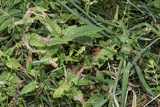Prochoreutis myllerana (Fabricius, 1794) Species
Last modified: Dec. 27, 2025, 7:24 p.m.
A very rare and local species in Belgium.
Details
- Classification
- Family: Choreutidae > Subfamily: Choreutinae > Genus: Prochoreutis > Species: Prochoreutis myllerana
- Vernacular names
- Glidkruidmot (NL), Small Metal-mark (EN), Myllers Helmkraut-Spreizflügelfalter (DE)
- First mention in Belgium
- De Fré Ch. 1858. Catalogue des Microlépidoptères de la Belgique. — Annales de la Société entomologique belge 2: 45–162. On page 59.
- Status
-
Native
Distribution
Imago
Wingspan 10–14 mm. In the very similar species Prochoreutis sehestediana, the white spots are less clear and also arranged a little differently. This species also has a light brown subterminal fascia that is missing or not so obvious as in P. myllerana.
Bionomics
The larvae are first mining, later living in a loose spinning in a shoot or between two leaves. It is not known how the winter is passed, but most probably in the adult stage, because the usual food plant is often flooded during winter and would not produce sufficient growth in early spring to support larvae.
The moths are active during the day, flying over the food plant and later coming to light.
Flight periods
The adults fly at least in two generations per year from late May to July and again from August to early September.
Observed on
- Host plant (species):
- Scutellaria galericulata and Scutellaria minor
The larva lives on Scutellaria galericulata, S. minor and Lamium.


